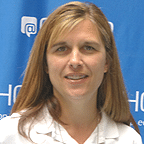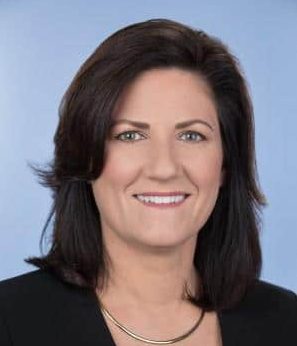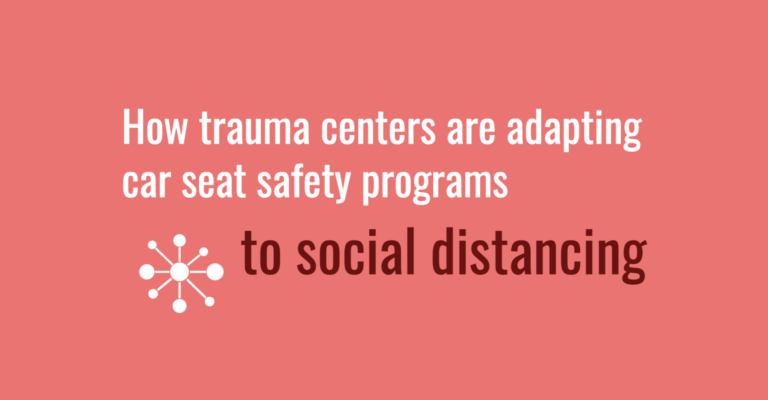Child car seat safety programs rely on personal contact and one-on-one education. COVID-19 has made this “high-touch” model unfeasible. In response, injury prevention leaders have adapted car seat distribution and fitting programs to social distancing requirements.
“When the pandemic hit, we had to cancel all in-person car seat checks,” said Gina Duchossois, MS, injury prevention manager at Children’s Hospital of Philadelphia (CHOP). “So we looked at what we could change about our program to make it safe but still provide education.”
Duchossois recently explained to me how her team incorporated remote video and social distancing into CHOP’s car seat safety program. I also spoke with Christy Adams, RN, MPH, PhD, trauma prevention coordinator at UC Davis Health, who described similar changes implemented at her trauma center.
Both injury prevention leaders said maintaining car seat distribution and education is a top priority. “In the end, we decided this program was just too important for us not to figure out a way to make it happen,” Duchossois said.
Drive-through car seat distribution
Both CHOP and UC Davis have converted car seat distribution to a low-touch, drive-through process.
At CHOP, eligible parents can schedule a car seat pick-up by phone. A hospital staff member calls parents one day before their appointment to conduct a quick coronavirus screen. Individuals who screen positive for symptoms or possible exposure are rescheduled for a future pick-up time.

Car seat distribution takes place in the parking lot of an off-site CHOP location. “The parent simply pulls up in the designated drive-through, and then a staff member wearing a mask and gloves hands them the car seat, an instructional DVD, a one-page information sheet and a resource on how to schedule a virtual car seat check,” Duchossois said. “Time spent next to the car is minimal. Many times the staff member just puts the car seat directly into the recipient’s trunk, and family members do not exit the vehicle at all.”
At UC Davis, parents watch a brief instructional video online then attend a live video car seat installation demonstration prior to the car seat pick-up appointment. They also have the option to receive on-site instruction during car seat pick-up. “The car seat technician will stand at a distance while wearing a mask and talk the individual through the installation,” Adams said. “Then the tech watches how the parent installs the seat and provides feedback.”
Virtual car seat checks
Both hospitals also offer remote car seat checks via live video. At CHOP and UC Davis, parents use an online form to request a virtual car seat check. The form gathers information about the make, model and year of the vehicle, the car seat type, and the age, height and weight of the child. Program staff review each request and schedule appointments by email.
At CHOP, the car seat check itself takes place on WebEx. “During the virtual check, the parent takes their smartphone or tablet to their vehicle,” Duchossois said. “The technician takes the parent through a series of steps to check for correct installation. If adjustments are needed, the tech guides the parent through the corrections.”
The CHOP virtual check also covers infant carriers. “Most parents have a base installed in the vehicle and a separate car seat carrier,” Duchossois said. “We go through all the carrier adjustments with them — how to loosen it, how to tighten it — and talk about accessories, such as infant positioning pillows.”

UC Davis staff perform virtual car seat checks in a “mini studio” created for the purpose. The studio includes a vehicle bench seat and other props. Car seat checks take place on Zoom.
“The tech first walks through the process of installing and adjusting a car seat in the mock vehicle and then demonstrates the process with a doll,” Adams said. “We then have the parents do a return demo with their car seat.”
Pros and cons of remote IP
Not every injury prevention program can be delivered using remote tools. According to Adams, violence prevention programs that depend on personal trust are hard to replicate in a digital setting. In addition, the “A Matter of Balance” fall prevention program has been temporarily suspended because it has not yet been evaluated for remote delivery.
And while virtual car seat checks are largely a success, Duchossois thinks live video cannot fully replace personal contact. “There is something to be said for meeting families and actually getting into their vehicle with them and helping them adjust all the belts and seats,” she said. “That’s the only downfall to this process because it is always great to meet people in person.”
According to Duchossois, injury prevention professionals are learning to adapt to remote tools.
“What I learned personally is to slow down a little bit and make sure I am using terminology that parents understand,” she said. “For example, if you refer to the ‘harness retainer clip’ during a virtual check, the parents likely don’t know what that means. So I will say, ‘Show me the inside of the seat. Now take hold of the harness and move your hand to the clip – that’s the ‘chest clip’ and it goes at armpit-level.’”
While there are drawbacks to virtual injury prevention, there are also benefits. Duchossois said remote tools have allowed CHOP to reach a larger population.
“With in-person car seat checks, we really just served people in the Philadelphia area,” she said. “But with our virtual process, we have done car seat checks for people throughout Pennsylvania and even out of state. It’s letting us reach a larger population of families.”
Virtual car seat checks are also more convenient for parents. “In the past, our evening and Saturday time slots booked up fast, so people often had to wait a month to get an appointment,” Duchossois said. “Now, parents can get an appointment in a couple of days and often the very next day.”
Adams believes virtual car seat checks will remain an option even after the pandemic subsides.
“Parents love it because it gives them much more flexibility, especially if they do not need to pick up a car seat,” she said. “They don’t need to take time off, they don’t need to get child care, and they don’t have to drive anywhere. Moving forward, I think we will see much greater accessibility to this service for families.”
According to Adams, virtual car seat checks might even provide a better learning experience for parents.
“Historically, the model for this kind of program is that the tech provides education and then the parents install the seat while the tech observes,” she noted. “But the reality is in some programs, the techs may be doing more of the installing than the parents.”
“But with the virtual model, the parents have no choice—they have to install the seat,” Adams said. “Tactile learning is kind of forced on them, which could lead to higher levels of retention and greater self-efficacy. The tech provides visual and verbal guidance, but parents have to do this 100 percent by themselves.”
Robert Fojut is the editor of Trauma System News.

